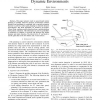Free Online Productivity Tools
i2Speak
i2Symbol
i2OCR
iTex2Img
iWeb2Print
iWeb2Shot
i2Type
iPdf2Split
iPdf2Merge
i2Bopomofo
i2Arabic
i2Style
i2Image
i2PDF
iLatex2Rtf
Sci2ools
IROS
2006
IEEE
2006
IEEE
Toward Online Probabilistic Path Replanning in Dynamic Environments
— This paper presents work on sensor-based motion planning in initially unknown dynamic environments. Motion detection and modeling are combined with a smooth navigation function to perform on-line path planning in cluttered dynamic environments. The SLIP algorithm, an extension of Iterative Closest Point, combines motion detection from a mobile platform with position estimation. This information is used via probabilistic prediction to estimate a traversal risk function that unifies dynamic and static obstacles. The risk is fed to E∗ and leads to smooth paths that trade off collision risk versus detours.
Related Content
| Added | 12 Jun 2010 |
| Updated | 12 Jun 2010 |
| Type | Conference |
| Year | 2006 |
| Where | IROS |
| Authors | Roland Philippsen, Björn Jensen, Roland Siegwart |
Comments (0)

